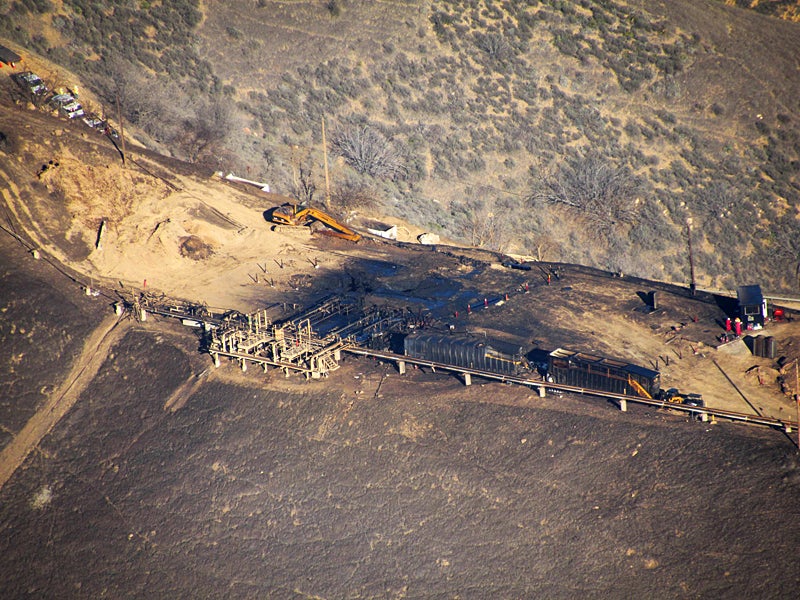Massive Gas Leak Puts Californians’ Health and Environment in Jeopardy
A massive gas leak near the town of Porter Ranch is releasing as much methane in a month as a fleet of 200,000 cars would in a year.

This page was published 9 years ago. Find the latest on Earthjustice’s work.
Since October, people across the nation have been monitoring a massive leak at SoCal Gas’ natural gas storage facility in the San Fernando Valley. This is the largest underground methane storage facility in the western United States, and the leak is one of the largest environmental disasters ever in Southern California. At a recent public hearing on the gas leak, frustration at the manmade environmental disaster threatened to boil over. Earthjustice is working with groups who want the storage facility shut down because the laws and regulations are not in place to allow this old and deteriorated facility to operate safely.
Lawsuits have been filed, California’s elected leaders have vowed to take action and Governor Brown has even declared a State of Emergency. The leak, called the Aliso Canyon leak or the Porter Ranch leak, is a local nightmare that has led to health impacts, such as headaches and nausea, and a dramatic reduction in quality of life for local residents.
The effects of this leak are immense. Thousands of people have been displaced and two schools have been relocated. But that’s not all. The implications for climate change are also severe, especially given California’s desire to be a climate leader. One University of California, Davis scientist estimated that the nearly 100,000 pounds of greenhouse gases spewed into the atmosphere every hour from the methane leak is equivalent to “the weight of a U.S. Navy super carrier every month.” The EPA has stated that, “Pound for pound, the comparative impact of [methane] on climate change is more than 25 times greater than CO2 over a 100-year period.”
The leak is also a call to arms about flaws in the oversight of complex fossil fuel infrastructure, especially in Southern California where residential developments sit side-by-side with flammable, polluting fossil fuel structures. In this case, the storage facility is spewing climate-changing greenhouse gas pollution hourly with a fix more than a month away. The leak is so difficult to address because engineers must slowly and carefully drill two relief wells thousands of feet into the ground to perfectly intercept the leaking 7-inch gas pipe. Reports have surfaced indicating that the leaking well did not include a safety valve, which does not appear to be required under current regulations.
The South Coast Air Quality Management District Hearing Board held a public hearing in the community at the Granada Hills Charter School near Porter Ranch on Saturday, January 9. This agency is responsible for ensuring oil and gas facilities are not creating a nuisance in the region. The hearing attracted one of the largest crowds ever—if not the largest—for a hearing before this board. Given the overwhelming public response, the board had to punt its decision on what to include in an abatement order for SoCal Gas until the following Saturday. (An abatement order requires a company not following the law to clean up its act or shut down.)
At the hearing, the air district staff and SoCal Gas presented their negotiated plan to address the leak. Their joint filing agrees that the company will monitor the leaking well, inspect the equipment at the entire facility over the next two years and fund a community health study, among other requirements. There will also be financial penalties associated with the leak, but the fees are negotiated privately by the air district legal staff and SoCal Gas.
Earthjustice worked with Food & Water Watch and Save Porter Ranch to provide input to the hearing board. These groups want more than the negotiated terms in place while SoCal Gas works to make the area safe again; they (and others) want the entire gas storage facility shut down. Per the negotiated agreement, SoCal Gas has two years to inspect the entire facility, and under the negotiated approach, the facility will be allowed to operate during this period. Many alarmed residents argue that if it takes two years to inspect the facility to ensure all wells are in working order, SoCal Gas should not be able to operate it in the interim. SoCal Gas needs to draw down the gas reserve as quickly as possible, but once emptied, there should be a complete moratorium on operations. Moreover, residents are calling for greater oversight and transparency over SoCal Gas’ required air monitoring activities.
Between the Santa Barbara oil spill last year and now this massive leak, Californians in particular are seeing strong evidence of the urgent need for action to protect our health and welfare from fossil fuel infrastructure. But they’re not alone. People across the nation face impacts from fossil fuel infrastructure, whether it’s oil and gas wells in neighborhoods or massive refinery complexes. There is clearly a lack of regulatory oversight to match the dangers of this aging infrastructure. Let’s hope the South Coast hearing board steps up to the challenge and places the interests of people and the environment over those of oil and gas companies.
The California Regional Office fights for the rights of all to a healthy environment regardless of where in the state they live; we fight to protect the magnificent natural spaces and wildlife found in California; and we fight to transition California to a zero-emissions future where cars, trucks, buildings, and power plants run on clean energy, not fossil fuels.